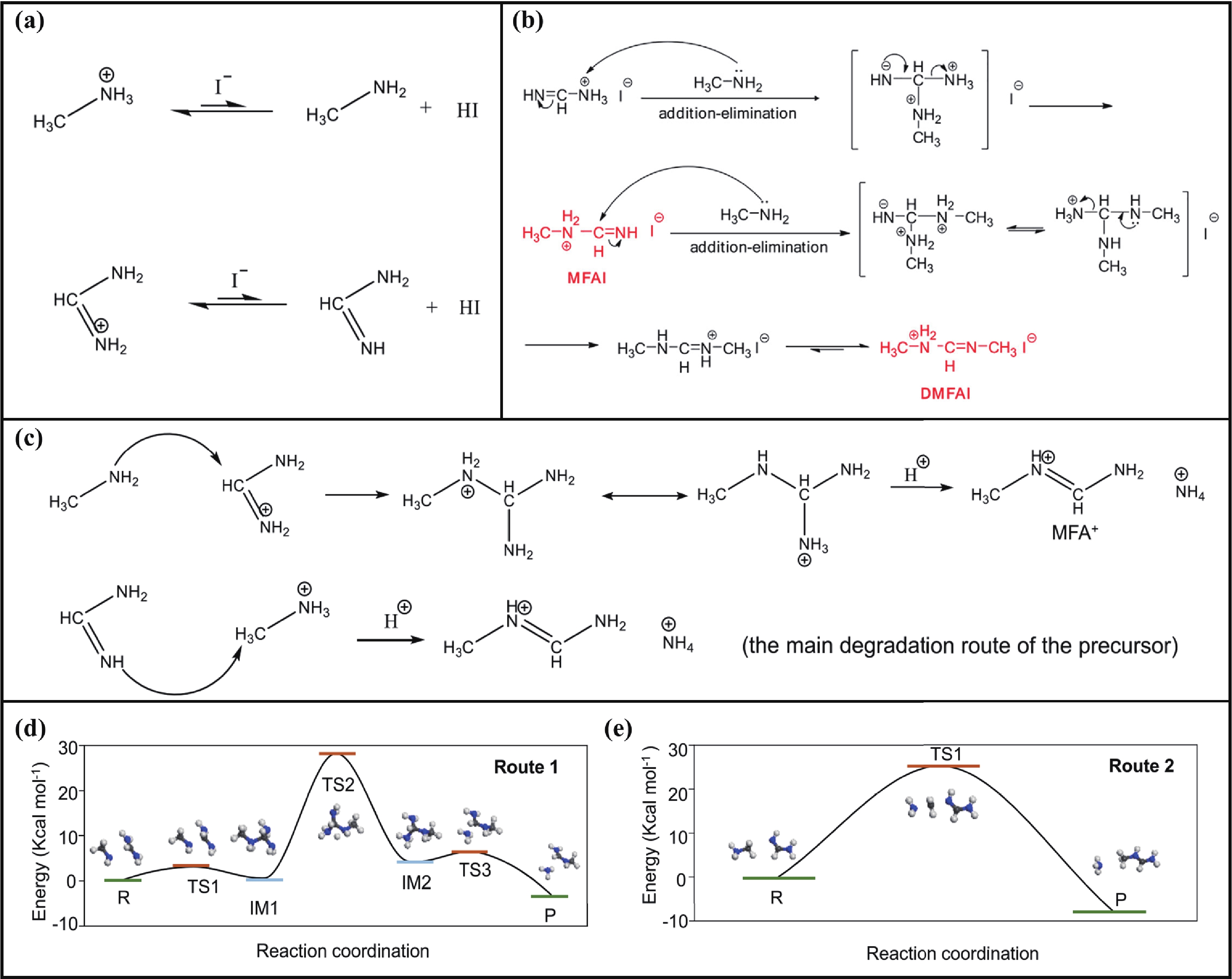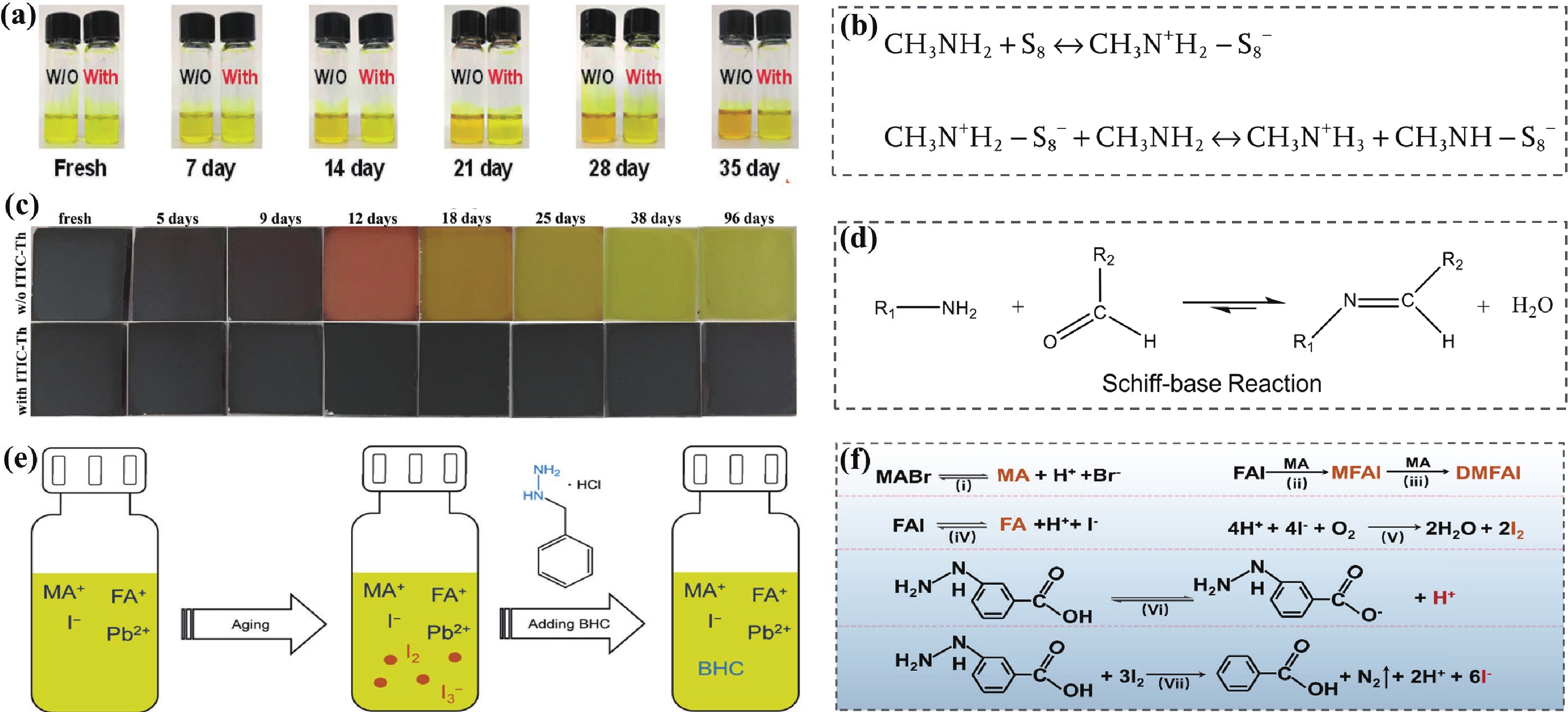| Citation: |
Mengjia Li, Lixiu Zhang, Cong Chen, Jiangzhao Chen, Liming Ding. The degradation of perovskite precursor[J]. Journal of Semiconductors, 2023, 44(1): 010201. doi: 10.1088/1674-4926/44/1/010201
****
M J Li, L X Zhang, C Chen, J Z Chen, L M Ding. The degradation of perovskite precursor[J]. J. Semicond, 2023, 44(1): 010201. doi: 10.1088/1674-4926/44/1/010201
|
-
References
[1] Lee J W, Tan S, Seok S I, et al. Rethinking the A cation in halide perovskites. Science, 2022, 375, eabj1186 doi: 10.1126/science.abj1186[2] Wang S, Tan L, Zhou J, et al. Over 24% efficient MA-free CsxFA1−xPbX3 perovskite solar cells. Joule, 2022, 6, 1344 doi: 10.1016/j.joule.2022.05.002[3] Chen C, Zheng S, Song H. Photon management to reduce energy loss in perovskite solar cells. Chem Soc Rev, 2021, 50, 7250 doi: 10.1039/D0CS01488E[4] Zhang L, Pan X, Liu L, et al. Star perovskite materials. J Semicond, 2022, 43, 030203 doi: 10.1088/1674-4926/43/3/030203[5] Zhang Y, Ma Y, Wang Y, et al. Lead-free perovskite photodetectors: Progress, challenges, and opportunities. Adv Mater, 2021, 33, 2006691 doi: 10.1002/adma.202006691[6] Boyd C C, Cheacharoen R, Leijtens T, et al. Understanding degradation mechanisms and improving stability of perovskite photovoltaics. Chem Rev, 2018, 119, 3418 doi: 10.1021/acs.chemrev.8b00336[7] Mei A, Sheng Y, Ming Y, et al. Stabilizing perovskite solar cells to IEC61215: 2016 standards with over 9, 000-h operational tracking. Joule, 2020, 4, 2646 doi: 10.1016/j.joule.2020.09.010[8] Liu Z, Liu P, Li M, et al. Efficient and stable FA-rich perovskite photovoltaics: From material properties to device optimization. Adv Energy Mater, 2022, 2200111 doi: 10.1002/aenm.202200111[9] Huang Y, Lei X, He T, et al. Recent progress on formamidinium-dominated perovskite photovoltaics. Adv Energy Mater, 2022, 12, 2100690 doi: 10.1002/aenm.202100690[10] Wang Y, Zhang X, Shi Z, et al. Stabilizing α-phase FAPbI3 solar cells. J Semicond, 2022, 43, 040202 doi: 10.1088/1674-4926/43/4/040202[11] Driscoll E, Orera A, Anderson P, et al. Raman spectroscopy insights into the α-and δ-phases of formamidinium lead iodide (FAPbI3). Dalton Trans, 2021, 50, 3315 doi: 10.1039/D0DT04300A[12] Kim M, Kim G H, Lee T K, et al. Methylammonium chloride induces intermediate phase stabilization for efficient perovskite solar cells. Joule, 2019, 3, 2179 doi: 10.1016/j.joule.2019.06.014[13] Wang X, Fan Y, Wang L, et al. Perovskite solution aging: What happened and how to inhibit? Chem, 2020(6), 1369 doi: 10.1016/j.chempr.2020.02.016[14] Dong Q, Shang W, Yu X, et al. Critical Role of organoamines in the irreversible degradation of a metal halide perovskite precursor colloid: Mechanism and inhibiting strategy. ACS Energy Lett, 2021, 7, 481 doi: 10.1021/acsenergylett.1c02449[15] Chen S, Xiao X, Gu H, et al. Iodine reduction for reproducible and high-performance perovskite solar cells and modules. Sci Adv, 2021, 7, eabe8130 doi: 10.1126/sciadv.abe8130[16] Li Z, Xing Z, Peng H, et al. Reactive inhibition strategy for triple-cation mixed-halide perovskite ink with prolonged shelf-life. Adv Energy Mater, 2022, 12, 2200650 doi: 10.1002/aenm.202200650[17] Chen C, Rao Y, Li Z, et al. Stabilizing formamidinium lead iodide perovskite precursor solution with phenylboric acid. Sol RRL, 2021, 5, 2000715 doi: 10.1002/solr.202000715[18] Min H, Kim G, Paik M J, et al. Stabilization of precursor solution and perovskite layer by addition of sulfur. Adv Energy Mater, 2019, 9, 1803476 doi: 10.1002/aenm.201803476[19] Qin M, Cao J, Zhang T, et al. Fused-ring electron acceptor ITIC-Th: A novel stabilizer for halide perovskite precursor solution. Adv Energy Mater, 2018, 8, 1703399 doi: 10.1002/aenm.201703399[20] Wang L, Zhou H, Hu J, et al. A Eu3+-Eu2+ ion redox shuttle imparts operational durability to Pb-I perovskite solar cells. Science, 2019, 363, 265 doi: 10.1126/science.aau5701[21] Li M, Gao D, Zhang B, et al. Multifunctional reductive molecular modulator toward efficient and stable perovskite solar cells. Sol RRL, 2021, 5, 2100320 doi: 10.1002/solr.202100320[22] Li M, Li H, Zhuang Q, et al. Stabilizing perovskite precursor by synergy of functional groups for NiOx-based inverted solar cells with 23.5% efficiency. Angew Chem Int Ed, 2022, 61, e202206914 doi: 10.1002/anie.202206914[23] Zuo C, Ding L. An 80.11% FF record achieved for perovskite solar cells by using the NH4Cl additive. Nanoscale, 2014, 6, 9935 doi: 10.1039/C4NR02425G[24] Wang A, Wang J, Niu X, et al. Inhibiting octahedral tilting for stable CsPbI2Br solar cells. InfoMat, 2022, 4, e12263 doi: 10.1002/inf2.12263[25] Ke L, Ding L. Perovskite crystallization. J Semicond, 2021, 42, 080203 doi: 10.1088/1674-4926/42/8/080203[26] Wang S, Zhang X, Zhu W, et al. Lewis base manipulated crystallization for efficient tin halide perovskite solar cells. Appl Surf Sci, 2022, 602, 154393 doi: 10.1016/j.apsusc.2022.154393[27] Wang H, Zhang L, Cheng M, et al. Compositional engineering for lead halide perovskite solar cells. J Semicond, 2022, 43, 080202 doi: 10.1088/1674-4926/43/8/080202[28] Jiang S, Xiong S, Dong W, et al. Constructing chromium multioxide hole-selective heterojunction for high-performance perovskite solar cells. Adv Sci, 2022, 2203681 doi: 10.1002/advs.202203681[29] Zhou J, Li M, Wang S, et al. 2-CF3-PEAI to eliminate Pb0 traps and form a 2D perovskite layer to enhance the performance and stability of perovskite solar cells. Nano Energy, 2022, 95, 107036 doi: 10.1016/j.nanoen.2022.107036[30] Xiao H, Zuo C, Liu F, et al. Drop-coating produces efficient CsPbI2Br solar cells. J Semicond, 2021, 42, 050502 doi: 10.1088/1674-4926/42/5/050502[31] Zhang L, Zuo C, Ding L. Efficient MAPbI3 solar cells made via drop-coating at room temperature. J Semicond, 2021, 42, 072201 doi: 10.1088/1674-4926/42/7/072201[32] Yu B, Zuo C, Shi J, et al. Defect engineering on all-inorganic perovskite solar cells for high efficiency. J Semicond, 2021, 42, 050203 doi: 10.1088/1674-4926/42/5/050203[33] Fang Z, Zhang L, Liu S F, et al. Organic ammonium halides enhance the performance of Pb–Sn perovskite solar cells. J Semicond, 2022, 43, 120202 doi: 10.1088/1674-4926/43/12/120202[34] Liu X, Yu Z, Wang T, et al. Full defects passivation enables 21% efficiency perovskite solar cells operating in air. Adv Energy Mater, 2020, 10, 2001958 doi: 10.1002/aenm.202001958[35] Fang Z, Zeng Q, Zuo C, et al. Perovskite-based tandem solar cells. Sci Bull, 2021, 66, 621 doi: 10.1016/j.scib.2020.11.006[36] Liu L, Xiao Z, Zuo C, et al. Inorganic perovskite/organic tandem solar cells with efficiency over 20%. J Semicond, 2021, 42, 020501 doi: 10.1088/1674-4926/42/2/020501[37] Cheng Y, Ding L. Perovskite/Si tandem solar cells: Fundamentals, advances, challenges, and novel applications. SusMat, 2021, 1, 324 doi: 10.1002/sus2.25[38] Zhao D, Ding L. All-perovskite tandem structures shed light on thin-film photovoltaics. Sci Bull, 2020, 65, 1144 doi: 10.1016/j.scib.2020.04.013[39] Xiao Y, Zuo C, Zhong J X, et al. Large-area blade-coated solar cells: Advances and perspectives. Adv Energy Mater, 2021, 11, 2100378 doi: 10.1002/aenm.202100378[40] Zuo C, Vak D, Angmo D, et al. One-step roll-to-roll air processed high efficiency perovskite solar cells. Nano Energy, 2018, 46, 185 doi: 10.1016/j.nanoen.2018.01.037[41] Lei T, Li F, Zhu X, et al. Flexible perovskite solar modules with functional layers fully vacuum deposited. Sol RRL, 2020, 4, 2000292 doi: 10.1002/solr.202000292[42] Huang K, Peng Y, Gao Y, et al. High-performance flexible perovskite solar cells via precise control of electron transport layer. Adv Energy Mater, 2019, 9, 1901419 doi: 10.1002/aenm.201901419[43] Li M, Zhou J, Tan L, et al. Multifunctional succinate additive for flexible perovskite solar cells with more than 23% power-conversion efficiency. The Innovation, 2022, 3, 100310 doi: 10.1016/j.xinn.2022.100310[44] Cheng Y, Yang Q D, Ding L. Encapsulation for perovskite solar cells. Sci Bull, 2021, 66, 100 doi: 10.1016/j.scib.2020.08.029 -
Proportional views






 DownLoad:
DownLoad:











 Mengjia Li:received her BE from Hebei University of Technology in June 2020. Currently, she is a PhD student in School of Materials Science and Engineering under the supervision of Prof. Cong Chen at Hebei University of Technology. Her research focuses on perovskite solar cells
Mengjia Li:received her BE from Hebei University of Technology in June 2020. Currently, she is a PhD student in School of Materials Science and Engineering under the supervision of Prof. Cong Chen at Hebei University of Technology. Her research focuses on perovskite solar cells Lixiu Zhang:got her BS degree from Soochow University in 2019. Now she is a PhD student at University of Chinese Academy of Sciences under the supervision of Prof. Liming Ding. Her research focuses on perovskite solar cells
Lixiu Zhang:got her BS degree from Soochow University in 2019. Now she is a PhD student at University of Chinese Academy of Sciences under the supervision of Prof. Liming Ding. Her research focuses on perovskite solar cells Cong Chen:is currently an associate professor at Hebei University of Technology. He received his PhD from Jilin University in June 2019. His research focuses on solar cells and NIR photodetectors
Cong Chen:is currently an associate professor at Hebei University of Technology. He received his PhD from Jilin University in June 2019. His research focuses on solar cells and NIR photodetectors Jiangzhao Chen:is a professor at College of Optoelectronic Engineering in Chongqing University. He received PhD from Huazhong University of Science and Technology and worked as a postdoc at Sungkyunkwan University and at the University of Hong Kong, respectively. His work focuses on perovskite solar cells
Jiangzhao Chen:is a professor at College of Optoelectronic Engineering in Chongqing University. He received PhD from Huazhong University of Science and Technology and worked as a postdoc at Sungkyunkwan University and at the University of Hong Kong, respectively. His work focuses on perovskite solar cells Liming Ding:got his PhD from University of Science and Technology of China (was a joint student at Changchun Institute of Applied Chemistry, CAS). He started his research on OSCs and PLEDs in Olle Inganäs Lab in 1998. Later on, he worked at National Center for Polymer Research, Wright-Patterson Air Force Base and Argonne National Lab (USA). He joined Konarka as a Senior Scientist in 2008. In 2010, he joined National Center for Nanoscience and Technology as a full professor. His research focuses on innovative materials and devices. He is RSC Fellow, and the Associate Editor for Journal of Semiconductors
Liming Ding:got his PhD from University of Science and Technology of China (was a joint student at Changchun Institute of Applied Chemistry, CAS). He started his research on OSCs and PLEDs in Olle Inganäs Lab in 1998. Later on, he worked at National Center for Polymer Research, Wright-Patterson Air Force Base and Argonne National Lab (USA). He joined Konarka as a Senior Scientist in 2008. In 2010, he joined National Center for Nanoscience and Technology as a full professor. His research focuses on innovative materials and devices. He is RSC Fellow, and the Associate Editor for Journal of Semiconductors



